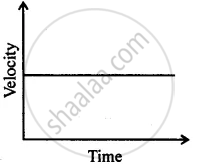Advertisements
Advertisements
प्रश्न
A packet is dropped from a stationary helicopter, hovering at a height ‘h’ from ground level, reaches the ground in 12s. Calculate
- the value of h
- final velocity of packet on reaching the ground. (Take g = 9.8 ms−2)
उत्तर
Height of the helicopter = h =?
Initial velocity = u = 0
Time = t = 12s
Acceleration = a = + g = + 9.8 ms−2
(1) S = ut + `1/2` at2
h = `0(12)+1/2(9.8)(12)^2`
h = 0 + 4.9 (144)
h = 705.6 m
(2) Let v = velocity of the packet on reaching the ground.
v = u + at
v = 0 + (9.8) 12
v = 117.6 ms−1
APPEARS IN
संबंधित प्रश्न
What term is used to denote the change of velocity with time ?
A car is travelling along the road at 8 ms-1. It accelerates at 1 ms-2 for a distance of 18 m. How fast is it then travelling ?
Define velocity. State its unit.
Differentiate between uniform acceleration and variable acceleration.
If a stone and a pencil are dropped simultaneously in vacuum from the top of a tower, then which of the two will reach the ground first? Give reason.
A bicycle initially moving with a velocity 5.0 m s-1 accelerates for 5 s at a rate of 2 m s-2. What will be its final velocity?
Derive the following equations for uniformly accelerated motion:
(i) v = u + at
(ii) `"S = ut" + 1/2 "at"^2`
(iii) v2 = u2 + 2aS
where the symbols have their usual meanings.
Can you suggest a real-life example about the motion of a body from the following velocity – time graph?

A stone thrown vertically upwards takes 3 s to attain maximum height. Calculate
- initial velocity of the stone
- maximum height attained by the stone. (Take g = 9.8 ms−2)
An electron moving with a velocity of 5 × 104 ms−1 enters into a uniform electric field and acquires a uniform acceleration of 104 ms–2 in the direction of its initial motion.
(i) Calculate the time in which the electron would acquire a velocity double of its initial velocity.
(ii) How much distance the electron would cover at this time?
